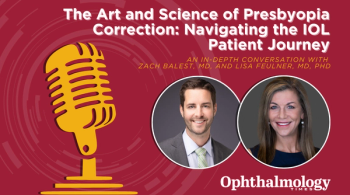
Drugs offer activation combination of Tie2 pathway in DR, DME
May provide better anatomic improvement, decreased DR severity scores
Tie2 activators combined with anti-vascular endothelial growth factor therapy translate to improved anatomic function and decreased diabetic retinopathy severity scores.
Reviewed by Peter K. Kaiser, MD
Tie2, a tyrosine kinase receptor, has become an important focus of research, and when combined with vascular endothelial growth factor (VEGF) therapy the two may provide better outcomes for patients with diabetic retinopathy (DR) and diabetic macular edema (DME) than with VEGF drugs alone.
How it works
During gestation, the Tie pathway is key to the development of the ocular and vascular structures and its absence is lethal to normal development, according to
In adults, the Tie pathway is the “gatekeeper” of vascular quiescence, he noted. It regulates blood and vascular homeostasis, inflammation, and pathologic angiogenesis and has a key role in cancer and diabetes. When things are working normally, the key Tie2 ligand, angiopoietin 1 (Ang1), binds and activates Tie2, which promotes the integrity of blood vessels.
Dr. Kaiser said this is done by forming into high order oligomers that produces clustering of the Tie2 receptor required for activation. In contrast to Ang1, Ang2 is a weak agonist that is released in the presence of hypoxia, inflammation, and VEGF.
Ang2 is mainly found in dimer form and does not cause Tie2 receptor clustering and thus no receptor activation. This leads to vascular leakage, inflammation, and vascular instability. The Tie receptors are found largely on endothelial cells that provide the microenvironment in which activation can occur.
“The Tie1 receptor is an orphan receptor that regulates Tie2 receptor trafficking and is necessary for full Tie2 activation,” Dr. Kaiser said.
RELATED:
Another player in this cascade is vascular endothelial-protein tyrosine phosphatase (VE-PTP), rheostat that modulates the effect of Ang2 on Tie2, Dr. Kaiser explained. VE-PTP dephosphorylates the Tie2 receptor and mediates cross-talk with the VEGF receptor 2, which shows how the tyrosine kinase pathways are interrelated. It works independent of Ang1 and Ang2.
Effects of ang and tie in retinal disease
Ang1 is protective against
Pharmaceutical intervention
The first drug tried to achieve this goal was
“The combination of Ang2 inhibitor and aflibercept led to decreased severity of DR, and the reduction was greater in association with higher Ang2 levels in patients with severe and proliferative disease,” Dr. Kaiser said.
A second drug,
The study also showed improved DR severity scores compared with anti-VEGF therapy alone, Dr. Kaiser emphasized. A third drug, AKB-9778 (Aerpio Pharmaceuticals), is a small-molecule inhibitor of VE-PTP. This formulation activates Tie2 regardless of the levels of Ang1 or Ang2, Dr. Kaiser explained. This activity is in contrast to the activity of nesvacumab that, when administered alone, did not significantly activate Tie2 in human endothelial cells.
The TIME2 phase IIa study of AKB-9778 also showed that the combination of the Tie2 activator and ranibizumab (Lucentis, Genentech Inc.) showed significant (p=.008) decreases in the central retinal thickness and the diabetic retinopathy severity compared with either of the drugs alone.
Interestingly, AKB-9778 is administered by subcutaneous injection. The results of elevated Ang2 levels are substantial: improved proteinuria, peripheral neuropathy, erectile dysfunction, myocardial function, and wound healing.
Conclusion
“Diabetic studies with three different Tie2 activators reported significantly improved anatomic measures and diabetic retinopathy severity scores compared with anti-VEGF alone,” Dr. Kaiser concluded.
“As a result of the unique mode of action and interplay between VEGF and Tie2 pathways, combining these modalities may achieve even better treatment outcomes in our diabetic patients.”
RELATED:
Disclosures:
Peter K. Kaiser, MD
E: [email protected]
Dr. Kaiser is a consultant to Aerpio Pharmaceuticals, Allegro Ophthalmics, Bayer, Regeneron, and SciFluor.
Newsletter
Don’t miss out—get Ophthalmology Times updates on the latest clinical advancements and expert interviews, straight to your inbox.














































.png)


